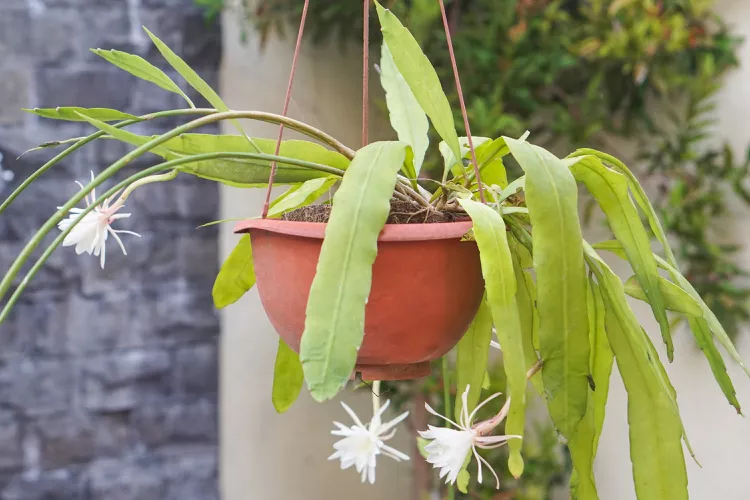
Tropical succulents belonging to the genus Epiphyllum are also known as orchid cactus or climbing cacti. There are more than a dozen species, along with other related hybrids in different sizes and shapes. Typically, their stems are long, flat, non-spiny, and trailing. They exhibit vivid, sizable, fragrant, and night-blooming flowers in the spring or summer with proper care. These predominantly epiphytic plants grow on tree branches or trunks in the wild as opposed to setting roots in the ground. They take in the nutrients and moisture they require from the damp surroundings.

Light
Filtered sunlight that resembles the lighting conditions found in their native tropical forest habitat is ideal for orchid cacti, which flourish in them. Keep them out of the full midday light to prevent burning or white scabbing, but a couple hours of full morning sun should be good. Growing in a hanging basket under a tree’s canopy is effective when done outside.
Avoid placing your Epiphyllum in a space where lights are left on after sunset for extended periods of time because this can affect flowering the next year.
Too much light may result in yellowing and withered growth in your plant. Too little light might cause delicate, leggy growth.
Soil
You shouldn’t plant your Epiphyllum directly in the earth. Normal dirt is extremely compact, and the roots won’t be able to handle it, which will cause the plant to die. Remain with a loose, quickly draining potting mix that contains additional light, porous components to aid in drainage. It may be effective to add perlite, bark, cocoa chunks, or pumice to an azalea mixture.
Water
The secret to good development with water is finding the perfect balance. In contrast to its relatives the typical cacti, orchid cacti require regular hydration during the growing season. Although damp, the potting mix shouldn’t be waterlogged. Prior to rewatering, you should ideally let the top third of the potting mix to dry out. Reduce watering over the winter and relocate the plant to a cooler area. The following season’s blossoms will be healthier and larger thanks to this. For these delicate plants, using distilled or filtered water is preferable to tap water.
If your soil is overly damp, especially when temps are on the cool side, you may see branch dieback or rust spots. If this continues to be an issue, cut off the infected branches, repot the plant in a dry, quick-draining mix, and water it less frequently.
Temperature and Humidity
The ideal way to cultivate Epiphyllum outdoors is in containers or hanging baskets so you can bring these delicate plants inside when the weather turns chilly. When it is cold outside or when the temperature falls below 32 degrees Fahrenheit, they won’t live.
Your orchid cactus may require a different location in the winter than it does during the growing season if you keep it indoors. From spring to fall, temperatures up to 90 degrees Fahrenheit are good, while in the winter, a cooler location with filtered light is ideal. The ideal range is between 50 and 58 degrees Fahrenheit, away from radiators and chilly draughts. Relocate to the warmer area once the blooms’ buds start to develop.
Higher humidity is necessary for Epiphyllum thriving. It can be beneficial to stand on a tray of moist pebbles, spritz the stems, or use a humidifier. Just make sure the plant’s roots aren’t absorbing the water.
Fertilizer
To promote healthy development and bud stimulation, sparingly fertilizing your Epiphyllum a couple of times a year is useful. Be careful not to overfeed them, too, as they normally thrive in an environment with few nutrients. It works best with a balanced, slow-release kind that has no more nitrogen than 10%. Early in the spring, a 2-10-10 spray might aid in promoting wholesome blooms.
Table





